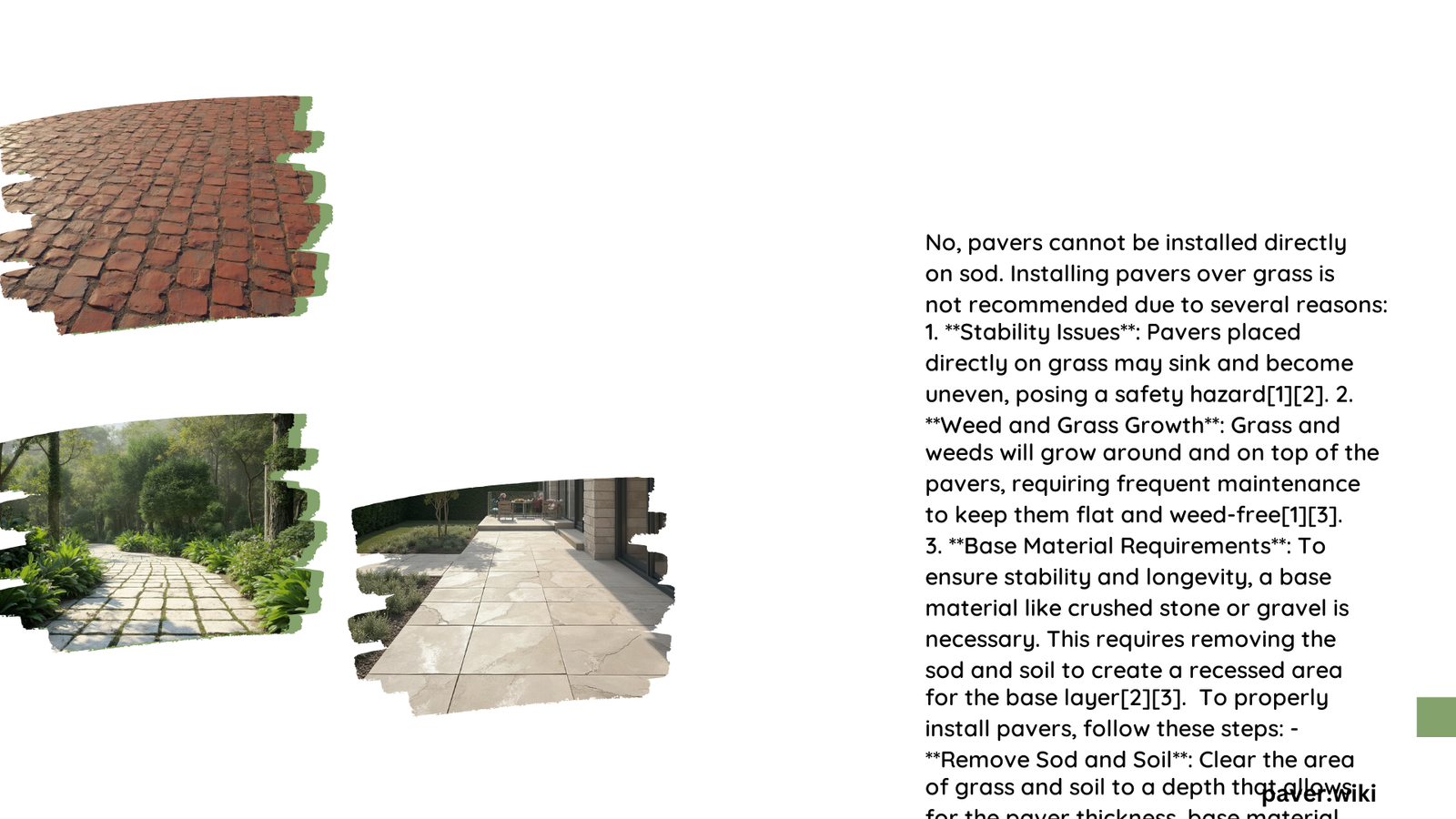Installing pavers on sod is not recommended due to potential issues with soil stability, drainage, and weight distribution. Proper paver installation requires removing sod, preparing a stable base, and ensuring adequate drainage. This guide explores the challenges of installing pavers on sod, best practices for sod removal, and alternative preparation techniques for a successful paver installation.
Can Pavers Be Directly Installed on Sod?
The short answer is no. Installing pavers directly on sod is not advisable due to several critical factors:
- Soil Stability
- Drainage Issues
- Weight Distribution Problems
Let’s explore each of these factors in detail.
What Are the Soil Stability Concerns?
Sod and the underlying soil can decompose over time, creating voids beneath the pavers. This decomposition leads to:
- Uneven surfaces
- Unstable paver foundation
- Potential tripping hazards
To ensure a stable foundation, it’s essential to remove the sod and organic materials before installing pavers.
Why Is Drainage a Critical Issue?
Sod and soil have poor drainage properties, which can cause several problems:
- Water accumulation under pavers
- Shifting and settling of pavers
- Potential cracking due to freeze-thaw cycles
Proper drainage requires:
- A well-compacted base
- Appropriate slope for water runoff
- Permeable materials to allow water to seep through
These drainage requirements cannot be met with sod in place.
How Does Weight Distribution Affect Paver Installation?
The weight of pavers and any traffic on them can cause:
- Uneven compression of sod and soil
- Sunken or raised areas in the paver surface
- Instability and potential safety hazards
A solid, compacted base is necessary to distribute weight evenly and prevent these issues.
What Are the Steps for Removing Sod Before Paver Installation?

Proper sod removal is crucial for a successful paver installation. Here’s a step-by-step guide:
- Mark the area for paver installation
- Use a sod cutter or spade to remove the sod
- Excavate the area to a depth of 6-8 inches
- Remove any remaining organic material
- Level and compact the soil
What Tools Are Required for Sod Removal?
To effectively remove sod and prepare the area for pavers, you’ll need:
- Sod cutter or spade
- Shovel
- Rake
- Plate compactor or steel tamper
- Level
- String lines
How Long Does Sod Removal Take?
The time required for sod removal can vary depending on the size of the area and the tools used. Here’s a general estimate:
| Task | Estimated Time |
|---|---|
| Removing sod with a sod cutter | 1-2 hours for a small to medium area |
| Excavating and preparing the base | 2-4 hours |
| Compacting the base | 1-2 hours |
What Are the Pros and Cons of Installing Pavers on Grass?
While it’s not recommended, some may consider installing pavers on grass. Let’s examine the pros and cons:
Pros:
- Potentially faster installation
- Less initial labor
Cons:
- Poor soil stability
- Inadequate drainage
- Uneven weight distribution
- Increased maintenance requirements
- Higher likelihood of weed growth
- Reduced durability and longevity
How Does Installing Pavers on Grass Affect Soil Health?
Installing pavers on grass without proper preparation can have long-term effects on soil health:
- Water accumulation leads to poor soil aeration
- Lack of sunlight can cause soil degradation
- Compaction from paver weight reduces soil quality
What Are the Maintenance Requirements for Pavers Installed on Grass?
Pavers installed on grass require significantly more maintenance:
- Regular leveling due to uneven settling
- Frequent weed removal
- Potential need for reinstallation due to instability
How Can Weed Growth Be Prevented When Installing Pavers?
To minimize weed growth when installing pavers:
- Remove all existing vegetation
- Use a geotextile fabric as a weed barrier
- Apply polymeric sand between paver joints
- Maintain proper drainage to prevent moisture accumulation
What Are the Cost Implications of Installing Pavers on Grass?
While installing pavers on grass may seem cost-effective initially, it can lead to higher long-term expenses:
- Increased maintenance costs
- Potential need for complete reinstallation
- Reduced property value due to poor installation
How Should Sod Be Prepared Before Laying Pavers?
If you must install pavers on an area with existing sod, follow these preparation techniques:
- Remove the sod completely
- Excavate to the proper depth (6-8 inches)
- Amend the soil if necessary
- Compact the soil thoroughly
- Add and compact base material in layers
What Soil Amendments Are Necessary?
Soil amendments may include:
- Adding sand to improve drainage
- Incorporating gravel for better stability
- Using lime to adjust soil pH if needed
What Are the Best Compaction Methods?
For effective compaction:
- Use a plate compactor or steel tamper
- Compact in layers no thicker than 2-3 inches
- Ensure even compaction across the entire area
How Important Are Moisture Levels in Soil Preparation?
Proper moisture levels are crucial for effective soil compaction:
- Too dry: Soil may not compact properly
- Too wet: Soil becomes unstable and muddy
Aim for a moisture level that allows for effective compaction without creating instability.
By following these guidelines and properly preparing the area, you can ensure a stable, long-lasting paver installation that adds value to your property.
References:
1. 10 Common Paver Installation Mistakes – Splendour In Stone
2. 6 Common Paver Installation Mistakes – Western Interlock
3. Paver Patio Installation Mistakes to Avoid – PWH Home Improvement
